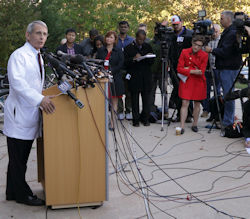SEJournal Online is the digital news magazine of the Society of Environmental Journalists. Learn more about SEJournal Online, including submission, subscription and advertising information.
 |
| Zoonotic diseases, those transmitted to humans from animals, include not just COVID-19, but earlier coronavirus outbreaks MERS and SARS. Above, a wet market in Guangzhou, China, like that many believed was a source of COVID-19 transmission. Photo: Tr1xx, Flickr Creative Commons. Click to enlarge. |
Backgrounder: Will Animal-To-Human Disease Transmission Bring the Next Big Pandemic?
EDITOR'S NOTE: This story is one in a series of special reports from SEJournal that looks ahead to key issues in the coming year. Visit the full “2022 Journalists’ Guide to Energy & Environment” special report for more.
 |
Analysis by Joseph A. Davis
Many journalists worry about the current COVID-19 pandemic. But just a few seem to worry about the next pandemic. There’s good reason for those few to include environmental journalists.
First, some basics. Humans are more defenseless against the “emerging” diseases their bodies have not encountered before. You may remember that COVID was once called a “novel” coronavirus, one the human body had apparently not encountered before. When human populations are immunologically “naive” to a pathogen, the risk of rapid transmission may be greater, because people have no immediate resistance.
All too often, these diseases are
passed on to humans from animals. ...
Such zoonotic diseases are not all new.
All too often, these diseases are passed on to humans from animals. The technical term is zoonotic transmission. COVID-19 is thought to be zoonotic. So were earlier coronavirus outbreaks — MERS in 2012-15 and SARS in 2003.
Zoonotic diseases are not all new. Malaria and bubonic plague, for example, are zoonotic diseases that have been around humans for hundreds of years.
In some cases, the animal species that infect us are part of a longer chain of transmission (e.g., the complex life-cycle of the malaria parasite). In some cases, the animal species is a domesticated one — such as the bird flu and swine flu (H5N1 and H1N1).
But in many other cases, the originating species is a wild animal. Ebola virus, for example, is believed to be zoonotic, possibly coming via nonhuman primates or fruit bats.
Eradication occurs, but not often
Contagious diseases seem to be eradicated once in a rare while.
Smallpox is thought to have been vanquished since 1980, except for some well-guarded lab samples. For that, there’s a vaccine to thank, along with the underappreciated science of public health. Poliomyelitis (polio) is also believed to be almost wiped out by vaccination.
Unfortunately, though, many other infectious pathogens are still in circulation — often because of natural reservoirs in wild species (prick up your ears, environment reporters).
Viruses mutate. This makes things interesting — and dangerous. An “endemic” disease is one restricted to a particular place or region. Endemics often persist because of natural reservoirs, or because humans are unable to control them. Because the endemic flu virus mutates all the time, we must come up with a new vaccine every year.
The term “epidemic” is often used to refer to a disease outbreak that may spread among a particular population (or populations) in a particular place and time.
Pandemics are worse. Pandemic diseases spread more rapidly than we can stop them, at an exponential rate of spread. That means pandemics end up spreading (or threatening to spread) to a wide area — multiple countries or regions. You’ll probably recall that the World Health Organization declared COVID-19 to be a pandemic in March 2020.
The truth matters more than the blame
The origins of COVID-19 are not fully known, and may never be. The origins of any disease are an important thing to know, but scientific evidence does not always make it immediately clear.
Generally, the two biggest competing hypotheses are 1) transmission from an unknown animal species or 2) accidental escape of a lab-contained virus (itself likely of animal origin).
In the case of COVID-19, several factors make the determination hard. The “wet market” in China where many believed COVID-19 was being transmitted was quickly removed and cleaned up — destroying physical evidence. Chinese institutions (from the Wuhan Institute of Virology to the Chinese Communist Party) have been less than fully transparent in the face of investigations.
But U.S. political players (and a good portion of the news media) have too often focused on narratives of “who’s to blame” rather than “what’s the truth.” The final truth may take much longer to figure out, if it can be determined at all.
Preparing for the last pandemic
The COVID-19 pandemic was predicted, or at least predictable, given all that was known before about where pandemics come from and how they spread.
Despite GOP assertions to the contrary, the Obama administration’s National Security Council and other agencies had developed a “playbook” in 2016 for addressing potential new pandemics. The nation’s encounters with avian influenza H5N1 and swine flu H1N1, as well as the 2014-15 Ebola threat, provided experience to base this on.
But the Trump administration in effect downgraded and ignored the playbook left to them. Trump downplayed the seriousness of the pandemic, misled the U.S. public about the nature of the health threat and sabotaged government action to address it. These failures made the pandemic worse, killing tens of thousands of additional Americans.
The Chinese could well have expected a
pandemic of zoonotic origin. Scientists
there were clambering through bat
caves looking for new viruses.
It wasn’t just Trump. Given the nature of the research at Wuhan Institute of Virology, the Chinese could well have expected a pandemic of zoonotic origin. Scientists there (e.g., the “bat woman”) were clambering through bat caves looking for new viruses. It wasn’t until after the COVID-19 outbreak that Chinese authorities shut down the Wuhan “wet market” where live wild animals were sold.
Understanding the animal-human nexus
Environmental journalists — more than most other journalists — will gain from cultivating an understanding of the ways humans come in contact with the “natural” (or nonhuman) world.
Zoonotic disease transmission is more common than many people think. Consider, for example, the many diseases that are transmitted via insects, like ticks and mosquitos.
Mosquitos bring us not just malaria, but yellow fever, the Zika virus, the West Nile virus and awful diseases like dengue fever and chikungunya. Ticks bring us not only Lyme disease, but tularemia, Rocky Mountain spotted fever, ehrlichiosis and the Powassan virus, to name only a few.
The creatures that carry disease organisms from one individual or species to another are called vectors. In some cases, other species are involved. A pathogen may be almost continually present in some species (called a reservoir) and transmitted to humans via one or more vectors.
A good example is the bubonic plague, the “Black Death” that killed some 30 percent or more of Europe’s population in the late Middle Ages. Its transmission is complicated. But it is believed that rats and other wild rodents act as reservoirs of the plague bacteria. Fleas are one vector that carries the bacteria from rats to humans.
Disturbing national species boundaries
Plague is sometimes endemic in mammal species like the prairie dog in the western United States. Problems can arise when human activity disturbs natural barriers between species (such as land-disturbing construction), allowing transmission from reservoir species like the prairie dog to humans. Plague is also capable of transmission from human to human, which makes things much worse.
Humans do a lot of things that
disturb the natural boundaries
protecting us from zoonotic disease.
Humans do a lot of things that disturb the natural boundaries protecting us from zoonotic disease. Digging up prairie dog burrows is just the beginning. There are places in the developing world where people hunt, sell and eat “bush meat” — from wild animals which may or may not be infected.
In other places, wild species like the scaly anteater known as the pangolin may be captured and sold for “medicinal” reasons. Pangolins may have been a vector in getting the COVID-19 virus to humans.
Problematic human disturbances may include agriculture (also the raising of wild animals), construction, earth-moving, deforestation, herding, etc. People may engage in these activities merely to survive, with little awareness of the potential for setting loose a global pandemic.
The point is that there are links between conservation of the natural world and the prevention of disease.
Preparing for the next pandemic
Of course, there are a range of other actions that will help us prepare for the next pandemic (like having enough oxygen, ventilators and nurses).
But awareness of the zoonotic disease transmission mechanisms is also an important beginning for heading off future pandemics. It can amplify the effectiveness of disease surveillance, prevention and treatment.
Public health agencies, whether national like the Centers for Disease Control or international like the World Health Organization, have a key role in the surveillance that could quash a potential future pandemic. Part of the job they need to do is simply keeping good statistics about the incidence of zoonotic and other diseases.
Public health agencies already know all this. But they are often underfunded and understaffed, even in richer nations like the United States.
Public information or disinformation?
Nowadays, too, news media can avoid being part of the problem by staying aware of its own role in possibly making things worse (such as when it fosters nonmicrobial pathologies that can worsen a pandemic).
 |
| Anthony Fauci at a 2014 Ebola press briefing. Photo: NIH, Flickr Creative Commmons. Click to enlarge. |
But all too often, public belief and public information have been weaponized for political purposes. Experts point to an “infodemic” of disinformation that is making the current pandemic much worse. Some people worked against public health, for instance, by denying the gravity of the pandemic, denying its causes and cures, and working to undermine public health agencies.
Governors in red states like Florida and Texas used their powers to incite resistance to public health measures like masks, distancing and vaccines. As a result of the plague of misinformation and disinformation, many people are being agitated to oppose the efforts of public health officials themselves. The attacks have been so ugly that some public health officials have quit.
For Trump himself, one goal was to blame the COVID-19 pandemic on China (thus absolving himself for its spread). Efforts to find the virus’ origins were politicized — and the news media often went along with a “who’s to blame” narrative.
But a proper, unpoliticized media understanding zoonotic disease could help prepare the United States and world nations for faster identification and response to the next pandemic.
The CDC has estimated that some 75 percent of new infectious diseases in humans come from animals. So if you want to get a jump on the next pandemic, this would be a good place to look.
One final hint for those on the “next pandemic” beat. Keep an eye on the CDC’s weekly journal “Emerging Infectious Diseases,” online free here. The language may be dry, but it’s a portal into fascinating and terrifying stories that may all too soon come your way.
Joseph A. Davis is a freelance writer/editor in Washington, D.C. who has been writing about the environment since 1976. He writes SEJournal Online's TipSheet, Reporter's Toolbox and Issue Backgrounder, and curates SEJ's weekday news headlines service EJToday and @EJTodayNews. Davis also directs SEJ's Freedom of Information Project and writes the WatchDog opinion column.
* From the weekly news magazine SEJournal Online, Vol. 6, No. 39. Content from each new issue of SEJournal Online is available to the public via the SEJournal Online main page. Subscribe to the e-newsletter here. And see past issues of the SEJournal archived here.














 Advertisement
Advertisement 



